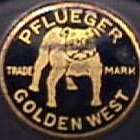I mostly fish kayak inshore and fly rod in limestone creeks. For my little bit of reservoir bass fishing, I've been known to cast wooden plugs (and prefer buzz baits) on my 1914 Talbot Niangua NLW with marked 1914 FE Thomas bait rod and braided silk.
What most people don't know about Meek and Talbot reels, the oil reservoirs on the end caps should be filled every day, because these reels used oil whirl for backlash control. In a cast, you can hear the oil whirl, and it works so hard, the oil evaporates.
Even older, I've never fished, but it's a hoot to cast, 8'3" Chubb Henshall bass rod with Bluegrass 33 NLW. It will slow-lob 3/8 oz to 150' easy. Backlash control is imbalance wobble in the spool, and your grandfather may have glued a nickel inside his old Marhoff spool to get the same effect. Doc Henshall first published the formula for this rod in 1876.
Marhoff's LW patent from 1908 forced everyone else to look into other LW mechanisms for the next 20 years. It wasn't until Ambassadeur that a really good free spool and centrifugal brake became the norm. Lew's (Shimano and Ryobi) and modern low profile baitcasters disengage the LW mechanim from the free spool. The strangest LW mechanism was Pflueger's 1918 Douglas patent, also free spool and anti-reverse.
The flyer falls forward during cast, and is disengaged from the spool. On retrieve, the flyer pushes the line to either side, where the yokes pick up the line and drop it in the groove. The arrow knob is a a tiny spring wire on a cam for backlash control, and works pretty well.
They discontinued the 1st model Supreme when they could copy Marhoff. But until Lew's, this strange reel would out-cast every other except NLW.
antique braided silk lines, btw, will last indefinitely if you dry them on a line winder to prevent mildew









